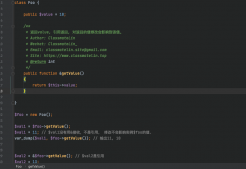本文实例讲述了PHP封装的Twitter访问类。分享给大家供大家参考。具体如下:
|
1
2
3
4
5
6
7
8
9
10
11
12
13
14
15
16
17
18
19
20
21
22
23
24
25
26
27
28
29
30
31
32
33
34
35
36
37
38
39
40
41
42
43
44
45
46
47
48
49
50
51
52
53
54
55
56
57
58
59
60
61
62
63
64
65
66
67
68
69
70
|
class Twitter { /** * Method to make twitter api call for the users timeline in XML * * @access private * @param $twitter_id, $num_of_tweets * @return $xml */ private function api_call($twitter_id, $num_of_tweets) { $c = curl_init(); curl_setopt($c, CURLOPT_URL, "http://twitter.com/statuses/user_timeline/$twitter_id.xml?count=$num_of_tweets"); curl_setopt($c, CURLOPT_RETURNTRANSFER, 1); curl_setopt($c, CURLOPT_CONNECTTIMEOUT, 3); curl_setopt($c, CURLOPT_TIMEOUT, 5); $response = curl_exec($c); $response_info = curl_getinfo($c); curl_close($c); if (intval($response_info['http_code']) == 200) { $xml = new SimpleXMLElement($response); return $xml; } else { return false; } } /** * Method to add hyperlink html tags to any urls, twitter ids or hashtags in tweet * * @access private * @param $text * @return $text */ private function process_links($text) { $text = utf8_decode($text); $text = preg_replace('@(https?://([-\w\.]+)+(d+)?(/([\w/_\.]*(\?\S+)?)?)?)@', '<a href="$1">$1</a>', $text); $text = preg_replace("#(^|[\n ])@([^ \"\t\n\r<]*)#ise", "'\\1<a href=\"http://www.twitter.com/\\2\" >@\\2</a>'", $text); $text = preg_replace("#(^|[\n ])\#([^ \"\t\n\r<]*)#ise", "'\\1<a href=\"http://hashtags.org/search?query=\\2\" >#\\2</a>'", $text); return $text; } /** * Main method to retrieve the tweets and return html for display * * @access public * @param $twitter_id, $num_of_tweets, $timezone * @return $result */ public function get_tweets($twitter_id, $num_of_tweets = 3, $timezone = "America/Denver") { $include_replies = false; date_default_timezone_set($timezone); // the html markup $cont_o = "<div id=\"tweets\">\n"; $tweet_o = "<div class=\"status\">\n"; $tweet_c = "</div>\n\n"; $detail_o = "<div class=\"details\">\n"; $detail_c = "</div>\n\n"; $cont_c = "</div>\n"; if ($twitter_xml = $this->api_call($twitter_id, $num_of_tweets)) { $result = $cont_o; foreach ($twitter_xml->status as $key => $status) { if ($include_replies == true | substr_count($status->text, "@") == 0 | strpos($status->text, "@") != 0) { $tweet = $this->process_links($status->text); $result .= $tweet_o . $tweet . $tweet_c . $detail_o . date('D jS M y H:i', strtotime($status->created_at)) . $detail_c; } } $result .= $cont_c; } else { $result .= $cont_o . $tweet_o . "Twitter seems to be unavailable at the moment." . $tweet_c . $cont_c; } return $result; }} |
希望本文所述对大家的php程序设计有所帮助。













